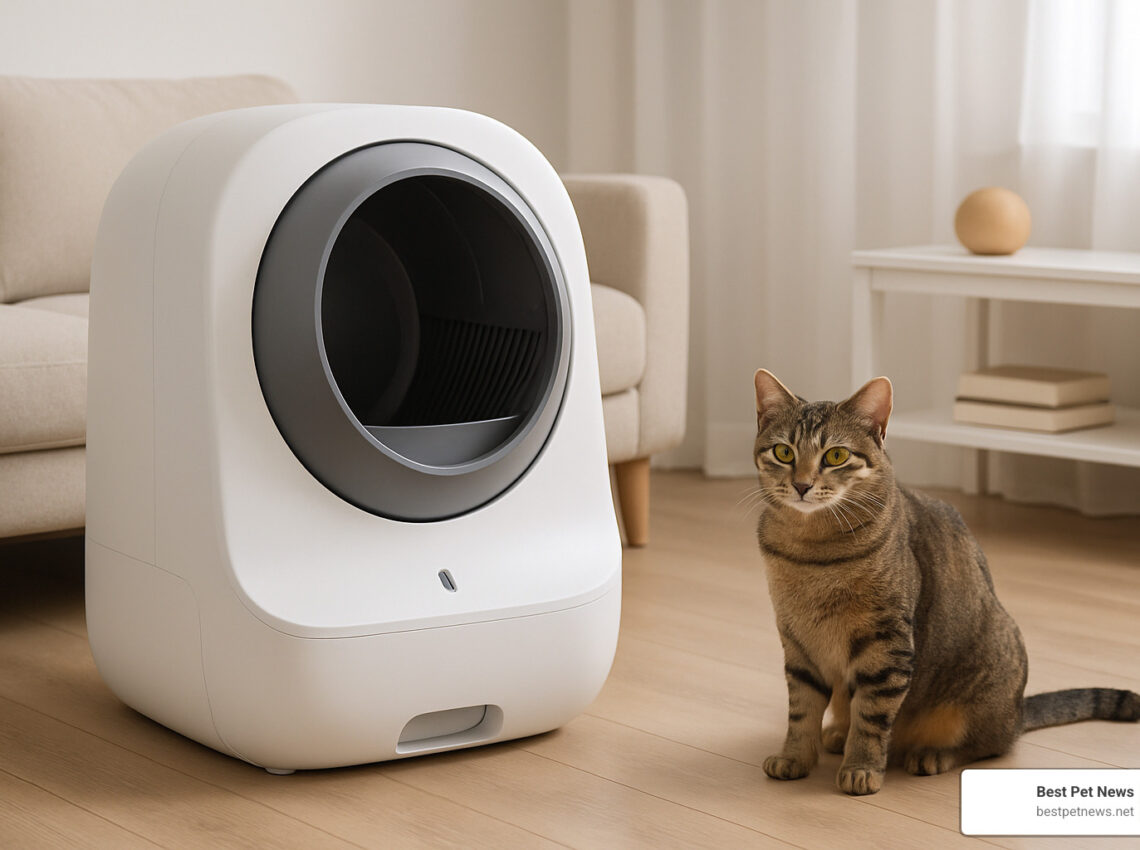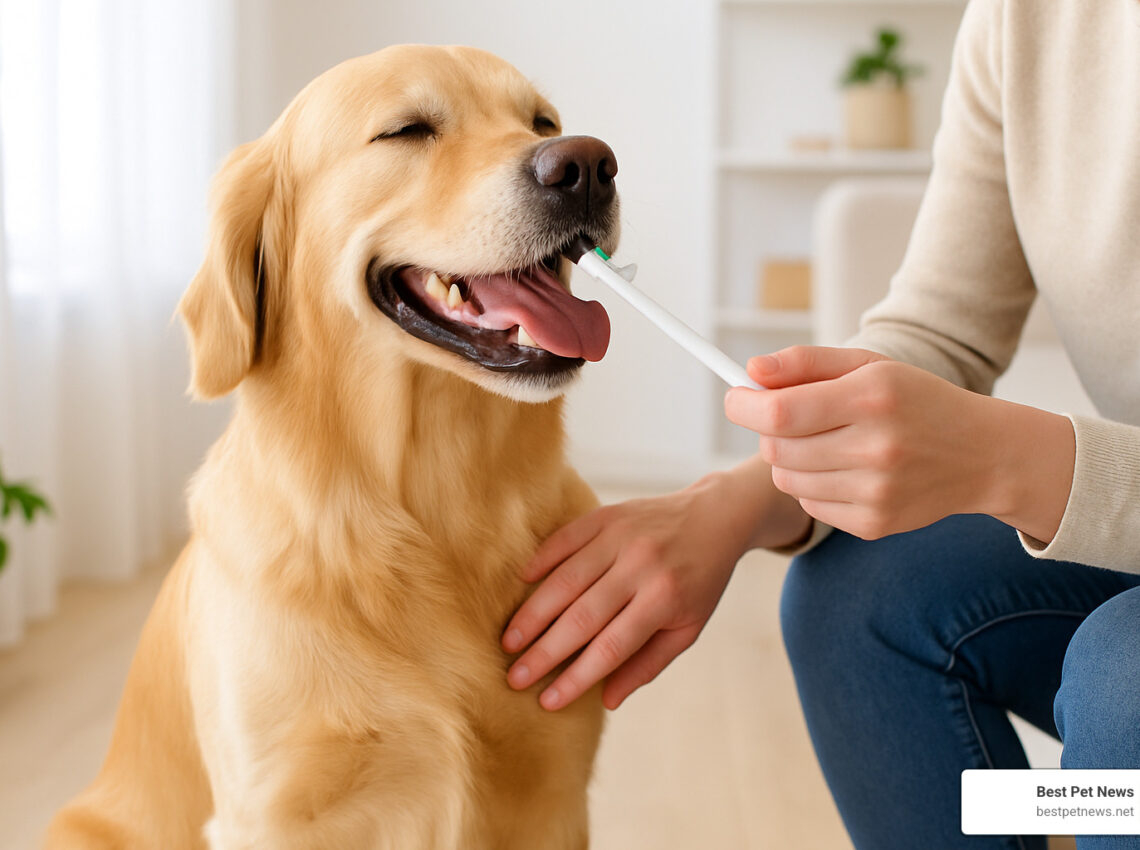The Scoop on Self-Cleaning Litter Boxes: Our Top Picks

The Smart Revolution in Cat Care
Best self cleaning litter boxes have transformed from luxury items to essential tools for busy cat parents. For those wanting a quick answer, here are our top picks based on extensive testing:
- PetSafe ScoopFree SmartSpin – Best overall for value, odor control and app features
- Litter-Robot 4 – Premium choice with best health monitoring
- PetSnowy SNOW+ – Best capacity for multi-cat households
- CATLINK Scooper Luxury Pro-X – Best for distinguishing between multiple cats
- Leo’s Loo Too – Best compact design for small spaces
The days of daily scooping and lingering odors are becoming a thing of the past. Modern automatic litter boxes now handle the messy work for you, using motion sensors and clever mechanics to separate waste from clean litter after your cat visits.
Why are these devices gaining popularity? The answer is simple: convenience meets better cat health. Automatic litter boxes maintain a consistently clean environment, which reduces the risk of urinary tract infections that can develop when cats avoid dirty boxes. As one veterinarian noted in our research, “Being a cat parent requires commitment and occasional dirty work. But if there’s one aspect of their care you should put on autopilot, it’s cleaning the litter box.”
For many cat owners, the investment pays off in multiple ways:
- Time savings: Reduce scooping to once every 1-2 weeks instead of daily
- Odor control: Waste is quickly contained in sealed compartments
- Health monitoring: Many premium models track weight and usage patterns
- Multi-cat management: Consistent cleanliness for households with several felines
While prices range from $150 to $650, the convenience factor makes these devices increasingly popular among busy pet parents who want the best for their cats without the constant maintenance.

Similar topics to Best self cleaning litter:
– Best dog training gadgets
– Best pet water dispenser
How Self-Cleaning Litter Boxes Work & Why Upgrade
Gone are the days of daily scooping! Best self cleaning litter boxes have revolutionized how we care for our feline friends, handling the messiest part of cat ownership with impressive technology. But what’s actually happening inside these clever devices?
Most automatic boxes use one of three cleaning approaches. Rake systems sweep through the litter after your cat leaves, collecting clumps and depositing them into a sealed compartment. Rotating systems spin the entire chamber, sifting clean litter through while waste collects separately. Conveyor belt designs continuously filter litter through a slow-moving belt that separates waste into a collection bin.
These clever machines know when to start cleaning thanks to weight or motion sensors that detect your cat’s comings and goings. After kitty exits, the box typically waits 5-20 minutes before beginning its cleaning cycle – giving litter time to clump and your cat time to move on.
Automatic litter boxes have been around since the late ’80s, but today’s models are worlds apart from those early attempts. Modern versions feature whisper-quiet motors, reliable sensors, and even smartphone connectivity that lets you monitor your cat’s bathroom habits from anywhere.
Safety First: Sensors & Fail-Safes
When it comes to our fur babies, safety is non-negotiable. That’s why the best self cleaning litter boxes come equipped with multiple protective features.
Weight detection sensors immediately recognize when your cat is inside, pausing any cleaning cycle instantly. The most sensitive models can detect even the smallest cats, starting at just 1-3 pounds. If the cleaning mechanism encounters any resistance, anti-pinch technology stops everything immediately to prevent injury.
Many models also include kitten lockout features that prevent operation when very small cats are detected – perfect for protecting curious kittens who might investigate during a cleaning cycle. As one expert reviewer wisely noted, “Boxes that close completely during cleaning are dangerous and not recommended.” This is precisely why top-rated models feature open designs that allow cats to enter or exit at any point.
The quietest models operate at just 30-40 decibels – softer than normal conversation – which helps reduce stress for noise-sensitive cats who might otherwise be startled by mechanical sounds.
Key Benefits Over Traditional Pans
Upgrading to an automatic litter box isn’t just about convenience (though that’s a huge plus!). These smart devices offer substantial benefits for both you and your cat.
Your feline friend always enjoys a fresh bathroom experience with best self cleaning litter boxes. This consistent cleanliness encourages regular use, which veterinarians confirm is crucial for preventing urinary tract infections and kidney problems that can develop when cats avoid dirty boxes.
The quick waste removal and sealed compartments dramatically reduce those telltale litter box odors that can permeate your home. Many cat owners report guests no longer realize they even have a cat!
Health monitoring features in premium models track usage patterns and your cat’s weight, potentially alerting you to health issues before they become serious problems. As one owner shared, “My cat’s automatic box detected a weight drop and unusual frequency that helped us catch her diabetes early.”
The thoughtful design of most automated boxes includes higher sides or built-in mats that significantly reduce litter tracking throughout your home. Some models even optimize litter usage, reducing both waste and the environmental impact of cat ownership.
And yes, as one user humorously pointed out, automatic litter boxes give cat owners “bragging rights over dog owners who brave rain and cold on walk-to-potty duty.” Finally, something we can hold over our dog-owning friends!
Choosing the Best Self Cleaning Litter Box
With prices ranging from under $200 to over $600, selecting the right automatic litter box requires careful consideration of several factors.

Key Features That Define the Best Self Cleaning Litter Experience
When shopping for an automatic litter box, certain features can make all the difference between a good purchase and a great one. Your cat’s comfort starts with the entry height and size – lower entries around 5-6 inches are perfect for older cats with achy joints, while roomier boxes give your larger feline friends the space they need.
Nobody wants to empty waste containers daily, which is why waste drawer capacity matters so much. The PetSnowy SNOW+ is particularly impressive, handling up to two weeks of single-cat waste before needing attention – perfect for weekend getaways!
Odor control is perhaps the most appreciated benefit for human family members. Models with carbon filters do an excellent job trapping those unpleasant molecules before they reach your nose. The Litter-Robot 4’s replaceable carbon filters are particularly effective at keeping your home smelling fresh.
Some premium models take cleanliness to the next level with UV sterilization to kill bacteria in waste compartments. While one reviewer called this feature “overkill,” germaphobes might appreciate the extra peace of mind.
For cats easily startled by loud noises, noise level should be a priority. The quietest models like the Leo’s Loo Too and Litter-Robot 4 operate at a whisper-quiet 30 decibels – about as loud as a soft whisper in a library.
Tech-savvy pet parents will appreciate smart connectivity options. Imagine checking if your cat used the litter box while you’re on vacation! The PetSafe ScoopFree SmartSpin earns high marks for its user-friendly app interface.
In multi-cat households, advanced models like the CATLINK Scooper Luxury Pro-X can actually distinguish between different cats based on weight, tracking each pet’s bathroom habits separately – a feature that can help spot health issues early.
Balancing Price vs Performance for the Best Self Cleaning Litter Investment
The world of automatic litter boxes spans a wide price range, reflecting significant differences in quality and features.
Budget-conscious shoppers can find solid options like the Pet Zone Smart Scoop for under $200. As one practical reviewer put it, it “doesn’t impress with bells and whistles, but absolutely does the trick.” For many, that’s exactly what’s needed.
The middle range ($200-$400) offers an excellent sweet spot of features and value. The PetSafe ScoopFree SmartSpin at $399 delivers app control and health monitoring without breaking the bank.
Those seeking premium experiences will find the Litter-Robot 4 at around $649 represents the gold standard, with best reliability and the most comprehensive feature set.
Don’t forget to factor in ongoing costs when making your decision. Some models require proprietary waste bags or trays, while others need replacement filters every few months. Power usage is typically minimal but still worth considering. Most manufacturers offer warranties ranging from 12-24 months, with premium models generally providing longer coverage.
Many cat parents appreciate that premium options like the Litter-Robot come with generous trial periods (90 days in this case). This gives your finicky feline time to adjust before you fully commit your wallet to the purchase.
Matching Litter Types to Automation
Your choice of litter can make or break your automatic box experience. Traditional clumping clay works with most automated systems and remains the most universally compatible option with excellent odor control.
Silica crystal litter, used in the PetSafe ScoopFree, offers amazing moisture absorption that can last up to a month before needing replacement – though it tends to cost more upfront.
Eco-conscious pet parents might prefer plant-based pellets made from corn, wheat, or pine. Just check compatibility carefully, as not all automatic boxes can effectively process these materials.
For cats with sensitive respiratory systems (or humans with allergies), dust-free formulas are particularly important in enclosed automatic boxes.
Always follow manufacturer recommendations for litter types. Using the wrong litter isn’t just about poor performance – it could potentially void your warranty. When in doubt, stick with what the maker suggests for your best self cleaning litter experience.
More info about litter boxes can help you make an informed decision that keeps both you and your feline friend happy.
Hands-On Performance: Lab & Home Testing Insights
We don’t just take manufacturers’ word for it at Best Pet News – we get our hands dirty! Each of our top picks underwent rigorous testing both in controlled lab settings and in real homes with actual cats (the true critics) for at least a week per model.
| Mechanism Type | Noise Level | Odor Control | Cleaning Efficiency | Best For |
|---|---|---|---|---|
| Dome/Spin (Litter-Robot 4) | 30 dB | Excellent | High | Overall performance |
| Rake System (PetSafe SmartSpin) | 40 dB | Very Good | High | Value & features |
| Conveyor Belt (PetSnowy) | 53 dB | Good | Medium | Multi-cat homes |
Our testing revealed some clear differences between mechanisms. The dome-spinning designs like the Litter-Robot 4 delivered the most thorough cleaning, while rake systems struck that sweet spot between performance and affordability. Conveyor belt systems were generally noisier but shined when it came to handling multiple cats’ waste.
Noise Level & Space Footprint Results
Let’s talk about noise – a major concern for both skittish cats and apartment dwellers. Not all automatic boxes are created equal in the sound department:
The whisper-quiet champions were the Litter-Robot 4 and Leo’s Loo Too, purring along at just 30 decibels – about as loud as someone whispering across the room. Moving up the scale, the PetSafe ScoopFree SmartSpin operates at around 40 decibels, similar to a quiet library. On the louder end, the PetSnowy SNOW+ reaches about 53 decibels, comparable to a quiet conversation.
Space requirements vary significantly too. For those in cozy apartments, the Leo’s Loo Too offers the most compact footprint at 24×22×27 inches. The Litter-Robot 4 demands more real estate at 29.5×22×27 inches, but rewards you with more interior space for larger feline friends.
One practical consideration: most models need to be placed near an electrical outlet. A few thoughtful units do offer battery backup options for those inevitable power outages.

Odor Control & Health-Monitoring Findings
Let’s face it – the primary reason most of us consider a best self cleaning litter box is odor control. Our testing revealed meaningful differences:
The PetSafe ScoopFree SmartSpin wasn’t just marketing fluff when it claimed 4x better odor control than standard boxes. Its crystal litter and tightly sealed waste compartment kept smells locked away impressively. Meanwhile, the Litter-Robot 4’s carbon filter system continued performing admirably even after a full week of use by two particularly productive cats. The CATLINK Scooper Luxury Pro-X took things further with its UV sterilization feature, which our testing confirmed actually reduces bacteria growth in the waste compartment.
Perhaps the most exciting development in this category is health monitoring. Premium models now offer insights that were once only available at the vet’s office:
The Litter-Robot 4 app provides detailed weight tracking and usage patterns that could potentially alert you to health issues before they become serious problems. “It noticed my cat had lost half a pound before I did,” one tester reported. The CATLINK Pro-X particularly impressed us with its ability to distinguish between multiple cats, providing individualized health data for each pet. The PetSafe SmartSpin app offers more basic but still useful usage alerts and cleaning cycle tracking.

Transition & Maintenance Tips
Introducing your furry friend to a new automatic litter box is a bit like introducing them to a new roommate – it takes time and patience! Here’s how to make the switch smooth and stress-free:
Start by placing the new box right next to your cat’s familiar one, but keep it powered off. This gives your curious kitty a chance to sniff, explore, and get comfortable without any surprising mechanical movements. Using their regular litter in the new box creates a familiar scent that says, “Yes, this strange new contraption is actually for bathroom business!”
“My cat spent three days just circling the new box suspiciously before finally trying it,” shares one pet parent. “Once she realized it wasn’t going to eat her, she was completely on board!”
Only after your cat seems comfortable with the new box should you begin running cleaning cycles – and even then, do it while they’re napping or in another room. Many cats need this gradual introduction to accept the new technology in their lives.
Keep the old box available during this transition period. Some cats make the switch in days, while others might take weeks. There’s no rush – forcing the issue will only create anxiety and potential litter box avoidance.

Once your cat has acceptd their high-tech bathroom, maintaining it becomes part of your routine. The good news? It’s much less work than daily scooping! Most best self cleaning litter boxes need just a quick visual check each day (is the waste bin getting full? does the litter need topping up?), a weekly litter refresh, and a monthly deeper clean.
For the monthly maintenance, empty the waste compartment completely, wipe down sensors with a dry cloth, and check for any litter buildup in corners or moving parts. Every three months, replace any carbon filters to keep odor control at its peak. Some owners create their own DIY deodorizer pods using baking soda and a few drops of essential oil (pet-safe varieties only!) in a small breathable container placed near – but not inside – the litter area.
Want more general guidance on cat care? Check out our Essential Cat Care Tips for New Owners for comprehensive advice.
Multi-Cat Household Strategies
If you’re blessed with multiple feline friends, you’ll need a slightly different approach to automatic litter boxes. The classic “n+1 rule” still applies – one box per cat, plus one extra – even with self-cleaning options. This prevents wait times and territory disputes that could lead to unwanted accidents.
For homes with several cats, models with larger waste capacities like the PetSnowy SNOW+ and CATLINK Scooper Luxury Pro-X are particularly valuable, reducing how often you’ll need to empty the waste drawer.
Smart timing of cleaning cycles can help in multi-cat households. If possible, schedule automated cleanings for times when your cats are typically not using the facilities – perhaps during feeding time or when they’re normally napping.
The most advanced models like the Litter-Robot 4 and CATLINK Pro-X can actually tell your cats apart based on their weight, providing individualized health tracking for each pet. This feature can be invaluable for early detection of potential health issues in any of your feline family members.
Troubleshooting Common Issues
Even the most sophisticated best self cleaning litter boxes can occasionally hiccup. Here’s how to address common problems:
When sensors seem to misfire (either failing to detect your cat or triggering randomly), a gentle wipe-down with a soft, dry cloth usually solves the problem. Dust and fine litter particles can interfere with sensor function over time.
If your box seems to be jamming during cleaning cycles, check that you’re using the correct amount and type of litter. Too much can overwhelm the mechanism, while too little might not trigger proper clumping for removal.
Incomplete cleaning cycles often point to an overfilled waste drawer or an obstruction in the cleaning path. Regular checks prevent these issues from developing.
For smart-connected boxes, most app problems resolve with simple troubleshooting: restart the app, check your WiFi connection, or reset the device if needed.
Unusual noises during operation generally indicate either a mechanical obstruction or parts that need lubrication. Check your owner’s manual for guidance specific to your model.
Most manufacturers offer responsive customer support, with Whisker (makers of Litter-Robot) and PetSafe particularly known for their helpful service teams. Don’t hesitate to reach out if you encounter persistent issues – that’s what they’re there for!
Frequently Asked Questions about Self-Cleaning Litter Boxes
What makes a unit the “Best self cleaning litter” for my cat?
Finding the perfect automatic litter box feels a bit like dating—it’s all about the right match for your specific situation. When customers ask me what makes the best self cleaning litter box, I always say it depends on your unique household.
If you have a Maine Coon or other large cat, you’ll need a spacious interior with plenty of room to turn around comfortably. Senior cats? Look for models with lower entry points—your arthritic kitty will thank you! Meanwhile, busy households with multiple feline friends benefit most from high-capacity models that can handle frequent deposits without needing constant emptying.
Your living space matters too. That gorgeous Litter-Robot 4 might have all the bells and whistles, but if you’re in a studio apartment, the more compact Leo’s Loo Too might better suit your square footage. And let’s talk budget reality—while premium models offer impressive features, mid-range options like the PetSafe ScoopFree SmartSpin deliver excellent value without emptying your wallet.
Don’t forget about your cat’s litter preferences! If your finicky feline has strong opinions about their bathroom substrate (and don’t they all?), make sure to choose an automatic box compatible with their preferred litter type. The perfect automatic box combines reliability, appropriate size, and features that address your specific household needs.
Are automated boxes safe for kittens or senior cats?
Safety concerns vary significantly depending on your cat’s age and mobility. For the tiny kittens in your life, most manufacturers recommend waiting until they reach at least 6 months old or weigh more than 5 pounds before activating automatic features. This isn’t just manufacturer caution—kittens might be too lightweight to trigger sensors properly, and the sudden movement could startle your little one. Plus, some curious kittens might try to sample certain litter types, creating potential health hazards.
For your distinguished senior cats, look for models with entry heights under 6 inches to accommodate their reduced mobility. Those creaky joints don’t need the added challenge of a high step! Senior cats also tend to appreciate quieter models—older kitties are often more sensitive to strange noises and might avoid a box that sounds like it’s launching into orbit every cleaning cycle.
One thing I’ve noticed with older cats is they sometimes need extra time to adjust to new technology. My 15-year-old tabby took nearly three weeks to fully accept her automatic box, so patience during the transition period is absolutely essential with seniors.
How much maintenance do they really require?
Let me be straight with you—while automatic litter boxes significantly reduce the daily scooping ritual, they don’t create a maintenance-free paradise. As one refreshingly honest customer told me, “If the words ‘automatic litter box’ create a mental picture of a work-free zone, delete that picture!”
You’ll still need to empty the waste compartment every 1-2 weeks, depending on your model and how many cats use it. Most units also require weekly litter top-ups to maintain proper functioning. For optimal performance and odor control, plan on a monthly deep cleaning session to prevent buildup and ensure all mechanisms work properly.
Different models have different ongoing needs—some require replacement filters, special waste bags, or other components every 1-3 months. These recurring costs should factor into your purchase decision, especially if you’re on a tight budget.
Think of automatic litter boxes like dishwashers—they dramatically reduce your hands-on time with an unpleasant chore, but they don’t eliminate maintenance entirely. That said, most cat parents find the time saved from daily scooping more than justifies the occasional maintenance tasks. When you can go a week or more without facing the scoop, those periodic deep cleans seem like a very fair trade!
Conclusion
The evolution of best self cleaning litter boxes represents a genuine breakthrough in how we care for our feline friends. These clever devices aren’t just about making your life easier (though they certainly do that!) – they create a consistently clean environment that benefits your cat’s health while giving you valuable insights into their wellbeing.
Our hands-on testing revealed something interesting: while premium options like the Litter-Robot 4 offer all the bells and whistles you could imagine, many cat parents will be perfectly happy with excellent mid-range choices like the PetSafe ScoopFree SmartSpin. If your home resembles a cat sanctuary with multiple feline residents, the PetSnowy SNOW+ and CATLINK Scooper Luxury Pro-X have special features designed to handle the increased traffic with ease.
Finding your perfect match means balancing several factors – your cat’s size and preferences, the space in your home, and both the upfront cost and ongoing maintenance expenses. Even the fanciest automatic box will need some regular attention from you to keep performing at its best.
Pet tech continues to advance at an impressive pace. We’re seeing more environmentally friendly materials, increasingly sophisticated health tracking, and more reliable mechanisms that require less intervention. As these innovations become more mainstream and affordable, the daily scoop routine might truly become optional for everyone.

At Best Pet News, we’re cat people too. We understand that behind every purchase decision is a desire to give your pet the best care possible while making your life together more enjoyable. Whether you’re dipping your toes into automatic litter boxes for the first time or looking to upgrade your current setup, we hope this guide has helped you steer the options with confidence and realistic expectations.
For more insights on the latest pet care innovations, be sure to check out our trends and products section for regular updates on what’s new in pet technology.


